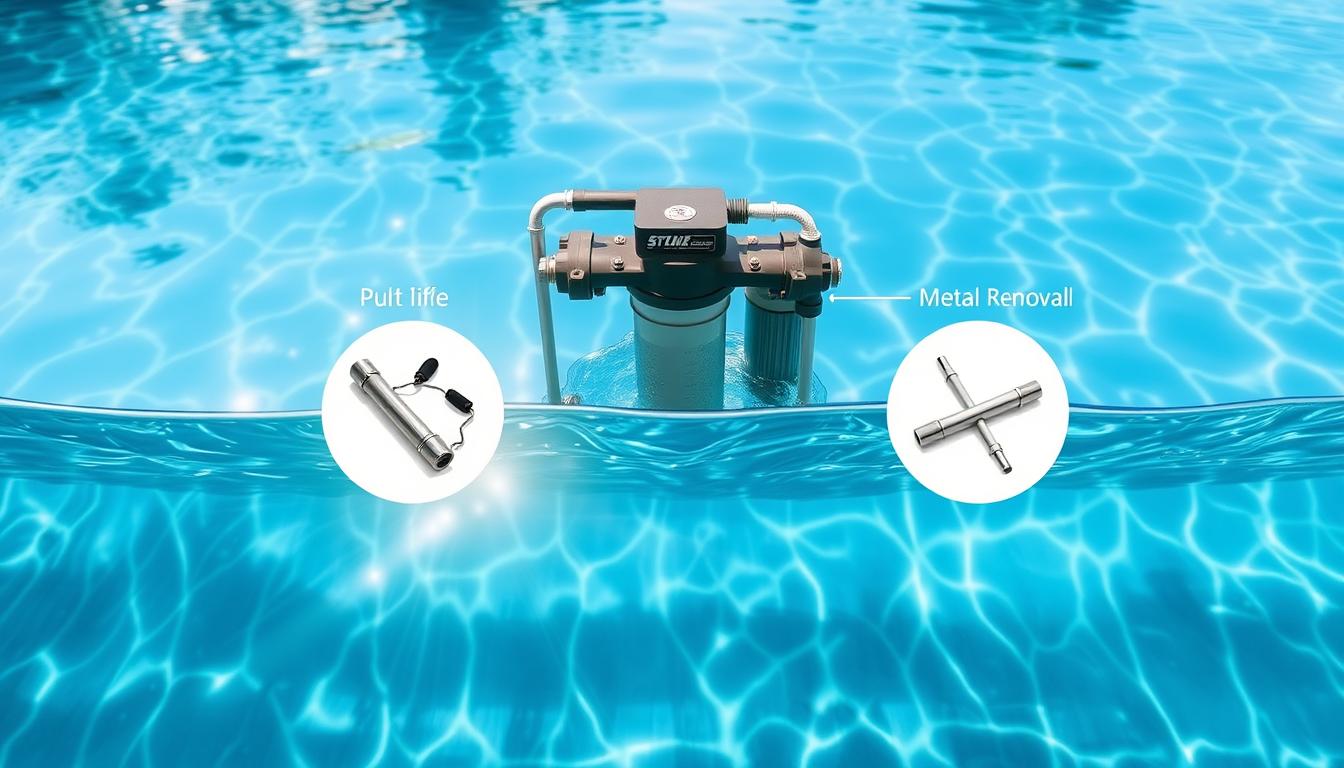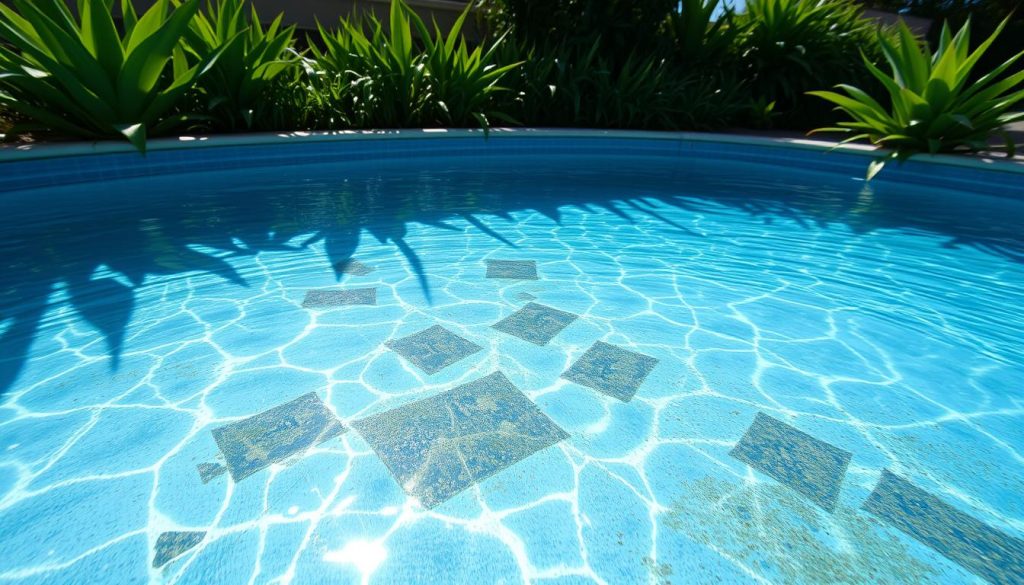
Over 85% of swimming pools have some metal contamination. High metal levels can cause stains and discoloration. Iron and copper are common culprits, leaving brown, red, or blue-green stains.
Don’t worry! We have expert tips to remove metals from pool water. These tips will also help prevent future metal staining.
To remove metal ions, know their sources and identify the specific metals present. Test your water to find out what’s in it. Follow our guide to restore your pool’s sparkle.
This will help you maintain a safe, inviting swimming environment. Your family and friends will love your clean, clear pool.
Understanding Metal Contamination in Pool Water
Metal contamination in pools can cause staining, discoloration, and reduced chlorine effectiveness. It’s crucial to know the sources of pool water metals. This knowledge helps maintain a safe and enjoyable swimming environment.

Common Metals Found in Pools
The most common metals in pool water are iron, copper, calcium, magnesium, and manganese. These metal ions can oxidize, causing staining and discoloration. Copper and iron are the main culprits behind pool staining issues.
| Metal | Acceptable Level (ppm) | Potential Issues |
|---|---|---|
| Iron | 0.2 | Reddish-brown stains |
| Copper | 0.2 | Blue-green stains, algae growth |
| Calcium | 200-400 | Scale formation, cloudy water |
| Magnesium | 30-50 | Scale formation, cloudy water |
| Manganese | 0.05 | Black or purple stains |
Sources of Metal Contamination
Metal contamination in pools can come from many sources. These include well water, municipal water supplies, and rainwater runoff from metal roofs or gutters.
- Well water or municipal water supplies containing dissolved metals
- Rainwater runoff from metal roofs or gutters
- Pool chemicals, particularly copper-based algaecides
- Corrosion of metal pool components, including pumps, heaters, and ladders
- Erosion of natural rock formations or soil surrounding the pool
Pool owners should regularly test their water chemistry to minimize metal contamination risk. Using metal sequestering agents or installing a pre-filter system can help. These steps ensure a cleaner, safer, and more enjoyable swimming experience for all.
Identifying Metal Stains and Water Discoloration
Metal stains in pools can be a headache for pool owners. Knowing the metal type is key for effective treatment. Let’s explore metal stains, testing methods, and acceptable levels for a healthy pool.
Types of Metal Stains
Metal stains in pools come in various colors. The color often hints at the metal causing the problem. Here are some common types of metal stains:
- Iron stains: These stains are typically dark brown, red, or blue-grey in color.
- Copper stains: Copper can cause blue, black, green, or purple stains in pool water.
- Calcium stains: These stains appear white or grayish-white and are often caused by high calcium levels in the water.
- Manganese stains: Manganese stains can be black, red, or green in color.
Testing for Metals in Pool Water
To find metal levels in your pool, get a pro water analysis. Regular test kits often miss metals. A pro test gives detailed metal content info.
This allows you to take the right steps to fix the problem. Regular testing helps keep your pool clean and safe.
Acceptable Metal Levels
The best metal level for pools is 0 ppm (parts per million). Levels under 0.2 ppm are usually okay. After using copper algaecide, levels may rise to 0.5 ppm briefly.
Keep an eye on metal levels often. Take action if they go above the safe range. This helps maintain a healthy pool.
| Metal | Ideal Level (ppm) | Acceptable Level (ppm) |
|---|---|---|
| Iron | 0 | < 0.2 |
| Copper | 0 | < 0.2 |
| Calcium | 0 | < 0.2 |
| Magnesium | 0 | < 0.2 |
| Manganese | 0 | < 0.2 |
Knowing metal stain types and testing methods helps address pool discoloration. Keeping metal levels in check ensures a clean, safe swimming environment.
How to Remove Metals from Pool Water
Balancing pool water chemistry is key to removing metals and preventing stains. Adjust pH to 7.4–7.6 and Total Alkalinity to 80–120 ppm. Lower Free Available Chlorine to 1.0 ppm or less.
Keep the pool pump running during treatment for optimal circulation. This ensures even distribution of treatment products throughout the pool.
Using Chelating or Sequestering Agents
Chelating agents are the go-to solution for removing metals from pool water. These products surround metal ions, holding them in solution. The pool’s filtration system then filters out these trapped metals.
Using these agents in your pool maintenance routine helps control metals. This minimizes the risk of staining and discoloration caused by metal buildup.
Applying Stain Removers
For existing metal stains, use a targeted stain remover. Products like Leslie’s Stain Remover tackle stubborn iron and copper stains. Follow the manufacturer’s instructions for best results.
Applying stain remover to affected areas can restore your pool’s appearance. This helps maintain an inviting swimming environment.
Utilizing Metal Removal Products
Specialized products like Leslie’s NoMetal and CuLator PowerPak remove dissolved metals from pool water. These solutions prevent future staining and maintain water clarity.
Incorporate these products into your regular pool maintenance. Follow a consistent treatment schedule to keep metal levels in check. This ensures a trouble-free swimming experience all season.







